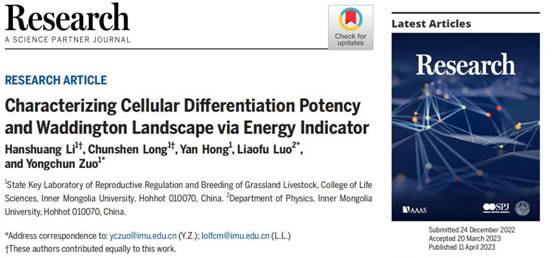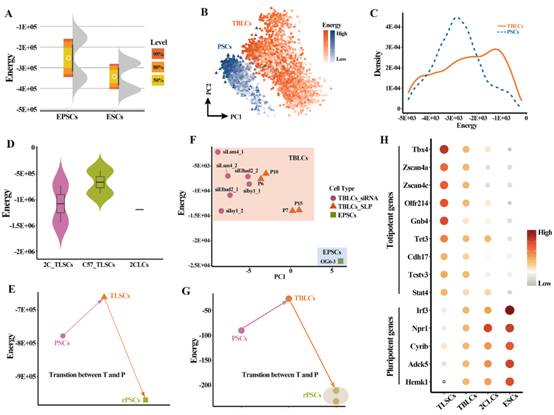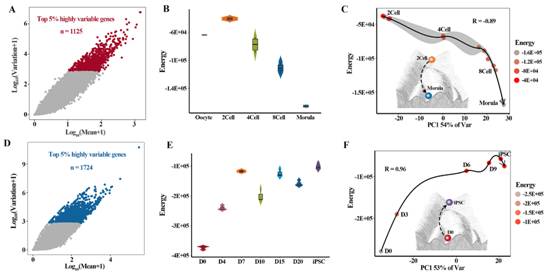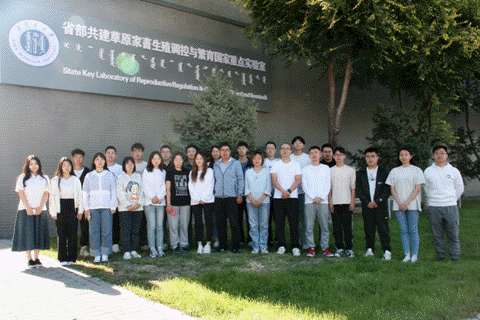Key achievements in the field of cell programming and re-programming of mammals have been made recently by the team of Prof. Zuo Yongchun in collaboration with Prof. Luo Liaofu from IMU and a thesis thereof entitled Characterizing Cellular Differentiation Potency and Waddington Landscape via Energy Indicator is published in Research, an internationally prestigious journal, in which a quantitative method of describing the early development of embryo and the state of cells in the re-programming of somatic cells of mammals in Waddington landscape based on energy indicator is proposed. Founded jointly by China Association for Science and Technology and American Association for the Advancement of Science in 2018, Research is the first top-class international comprehensive large OA journal for science and technology with great influence and a TOP journal in comprehensive Section 1 of the Academy of Sciences of China with the influence factor of 11.036, and has been designated as the most internationally influential academic journal in China for three years consecutively.

Waddington Landscape is a conceptual model for describing the process of cell differentiation, which is described as stones rolling into different valleys along different routes on the mountain slope. The different altitudes of cells in Waddington Landscape represent different cellar differentiation potency. The model is also expanded in many cases to explain processes including transdifferentiation and re-programming. However, quantitative description of such metaphorized model on the cellular level has always been one of the objects of studies in computational biology. Traditionally the differentiation potency of characterizing cells depend on such features as transcriptome and the state of chormatin with known markings. Although these cellular features can differentiate cells in specific stages, a small portion of markings cannot reflect the overall cellular features or be appropriate for identifying new cell groups.
In its studies, the project team propose a new energy index based on Hopfield, a recurrent neural network, which is capable of determining the differentiation potency of characterizing cells without relying on transcendental knowledge and thus providing a method for quantitative description of Waddington Landscape.

Diagram of the Waddington energy landscape development of early-stage embryos (left) and somatic cell reprogramming (right)
First of all, the results of the quantitative assessment of the differentiation potency of stem cells of different origins including TLSCs, TBLCs, 2CLCs, EPSCs and ECSs based on Hopfield energy conducted by the researchers show that the high differentiation potency and high energy of cells are interrelated, indicating that Hopfield energy can provide a more common method for measuring differentiation capacity than the feature of pluripotency.

Quantitative assessment of differentiation potency of different stem cells through Hopfield energy
Subsequently the researchers describe the Waddington energy landscape in the process of embryo development and re-programming of somatic cells. The energy landscape of single-cell resolution further proves that the destiny of cell is determined gradually in a continuous process. At the last stage, the project team conduct dynamic simulation of the continuous transformation of cell status in the course of embryo development and re-programming of somatic cells on Waddington energy landscape and propose that the Importance Score can effectively identify the key factors driving the transformation of the destiny of cells, providing theoretical guidance to purposeful regulation of the destiny of the destiny of cells.

Hopfield energy simulation of the process of embryo development and re-programming of somatic cells
The project is collaboratively completed by the School of Life Sciences, the State Key Laboratory of Reproductive Regulation & Breeding of Grassland Livestock and the School of Physical Science and Technology of IMU. The thesis has Li Hanshuang and Long Chunshen, doctoral candidates enrolled in 2021 as the first authors, and Prof. Zuo Yongchun and Prof. Luo Liaofu as the correspondent authors. The project is sponsored by the State Plan for Supporting High-level Special Talents, the National Natural Science Foundation of China (62061034, 62171241) and the Program of Inner Mongolia Autonomous Region for Key Technologies (2021GG0398).

The project team of Prof. Zuo Yongchun
A brief to the correspondent authors:
Luo Liaofu is one of the founding fathers of IMU and pioneers of physical science, a professor and PhD supervisor of IMU, one of the founders of the idea of bioinformatics in China, a renowned theoretical physicist theoretical biophysics in China, the proposer of the theoretical research route of biophysics of Code-Sequence-Conformation-Dynamics, who has contributed significantly to the fundamental research in this new interdisciplinary field. His published works include Quantum Field Theory, Non-equilibrium Statistical Theory, Collected Theses on Theoretical Biophysics, Physical Aspects on Life Evolution (Series of Scientific Monographs) and Theoretical-physical Approach to Molecular Biology (English version). Prof. Luo was awarded Prize for Advanced Worker at the National Science Conference in 1978, the First Prize in Scientific and Technological Achievements of Inner Mongolia Autonomous Region in 1980, the Third Prize for Natural Sciences and Special Prize of Baosteel Education Fund for Excellent Teachers in 1999, the titles of National Excellent Worker in Science and Technology and National Model Teacher in 2001, the title of National Excellent Talents in Professional Technologies in 2006, the Prize for Life Sciences of the Ho Leung Ho Lee Prize for Progresses in Science and Technology of the Ho Leung Ho Lee Foundation and the Second Prize for National Prizes for Progresses in Science and Technology in 2007, the First Prize of Inner Mongolia Autonomous Region for Natural Sciences and Prize for Special Contribution in Science and Technology of Inner Mongolia Autonomous Region in 2009, the title of The Most Beautiful Figures Supporting the Frontier Areas by the Department of Publicity of the CPC Central Committee in 2019 and the First Lifetime Achievements Award in China Biophysics issued by the Chinese Society for Bioinformatics (Preparatory) in 2020.
Zuo Yongchun is a Grade III professor and PhD Supervisor of the School of Life Sciences of IMU who was conferred Doctoral Degree in Biophysics at IMU in 2011 specializing in bioinformatics. Prof. Zuo has been awarded the titles of National Young Top-notch Talents, Grass Talent of Inner Mongolia, Young Science and Technology Talent of Inner Mongolia and selected for the 321 Talents Project of the New Century of Inner Mongolia. Prof. Zuo is in charge of 7 projects sponsored by the National High-level Special Talents Supporting Plan, the National Key Research & Development Sub-program (collaborative), the National Natural Science Foundation and the National Youth Key Projects and more than 10 projects sponsored by the Outstanding Youth Fund and Program for Key Projects of Inner Mongolia Autonomous Region. Prof. Zuo is currently holding positions of member of the editorial board of Current Gene Therapy, an international journal, secretary general of the Special Committee of Epigenetics-informatics of the Chinese Society for Bioinformatics, member of the Special Committee of the Chinese Society for Cell Biology, correspondent member of the Special Committee of the China Computer Federation, secretary general of the Health Digital Society of Inner Mongolia, assistant secretary general of the Biophysics and Bioinformatics Society of Inner Mongolia, etc. Prof. Zuo has published more than 80 academic theses as the first (correspondent) author in journals including Nucleic Acids Research, Research, Cellular and Molecular Life Sciences, Briefings in Bioinformatics which have been cited for more than 2,300 times, and 6 of which have been listed as ESI 1% most frequently cited theses.
URL for the thesis: https://doi.org/10.34133/research.0118

